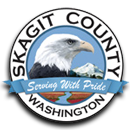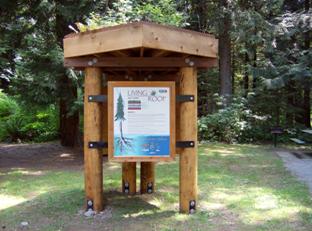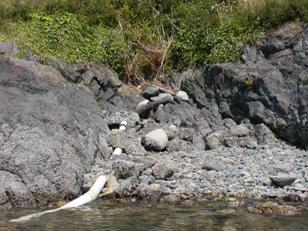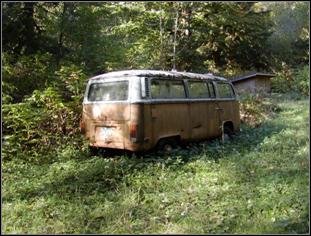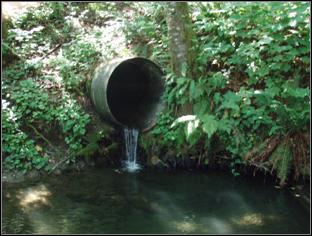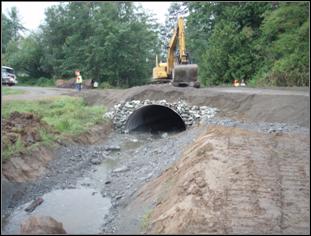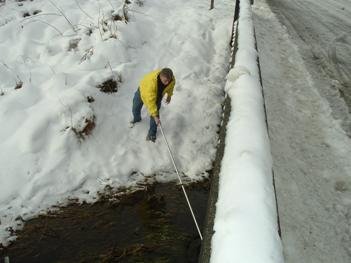Salmon Strategy
|
Skagit
County Salmon Recovery Projects
|
|||
|
Download our 2007
Salmon Action Report for a printable version of this list. Check
this page for the latest updates, and click the link in a project title
to learn more. The Salmon
Policy Resolution instructs county departments to work together
and with outside agencies to speed salmon recovery. Choose a department
below to jump to that section:
In 1996, local water utilities, cities,
Indian tribes, state agencies, and Skagit County entered a long-term
term memorandum of agreement regarding Skagit River water resources,
known as the 1996 MOA. The 1996 MOA includes a reciprocal promise
that local jurisdictions and the State of Washington will cooperate
to extend public water supplies to areas with low-flow salmon streams,
with the intent of ensuring that instream flows support productive salmon
habitat long into the long-range future. In accordance with that goal,
Skagit County has been engaged in supporting and facilitating extensions
of public water to low-flow areas. In 2007, Our community needs a predictable water
supply for human needs, but not at the expense of our salmon. The county
protects the integrity of salmon habitat by ensuring instream flows
are met in all river systems and tributary basins. In order to protect
flows in salmon streams into the future, Skagit County believes it is
critical that all parties to the 1996 MOA continue to act in a unified
manor to defend, promote, and finance the basic intent of the 1996 MOA. In early 2007, Skagit County was poised to launch a comprehensive
program to acquire conservation easements along key salmon streams in
agricultural areas. The effort, known as the Salmon Heritage
Program, was modeled on the countys successful Farmland
Legacy program, and was intended to address long-running controversy
over riparian habitat on actively-farmed land. The Salmon Heritage Program
planned to raise funds through a county-wide ballot measure, pay fair
market value for riparian habitat easements, and jointly manage that
habitat in cooperation with the tribal-led Skagit River System Cooperative. The initial public reaction to the Salmon Heritage Program
was positive, and polling data suggests broad support for habitat acquisition
as a means of balancing the environment and property rights. However,
the notion of raising county property taxes as the sole funding source
for such a program proved considerably less popular. The Completed: June 1, 2008 [expected] This projects goal is to measure the amount of existing vegetated
riparian area in agricultural areas and compare it to the amount of
potential vegetated riparian area if buffers were in place along all
watercourses. The project essentially attempts to answer the question,
How much riparian area is already protected? Ruckelshaus Center SSB 5248 Process In May 2007, the Legislature passed SSB 5248, creating a three-year
time out to the ongoing controversy and litigation over riparian buffers
on agricultural land. During the time-out, various stakeholders are
participating in a collaborative process at the UW/WSU William D. Ruckelshaus
Center, with the intent of creating a uniform and equitable plan for
protecting riparian habitat in agricultural areas. Because Skagit County
is squarely in the center of this statewide Growth Management Act dispute,
the county has made the Ruckelshaus Center process a high priority. The Board of Commissioners has appointed Special Deputy Prosecuting
Attorney Ryan Walters to serve as the countys liaison to the Ruckelshaus
Center. In this capacity, Walters is charged with coordinating the process
with all county departments, assembling information about the countys
current regulations and habitat status, and advocating for an outcome
consistent with Parks and Recreation Department Hansen Wetlands The wetlands within the Hansen Creek watershed provide an important
function for the health and viability of Hansen Creek. In 2007, SCPR
worked with the consulting firm Edge Environmental to improve and re-store
the important functions of these wetlands. This partnership increases
the aesthetic appeal of the park while at the same time improving the
biological value of our streams for indigenous fish and wildlife. Local
utility companies covered the costs of these restoration efforts through
a mitigation banking program. Alluvial Fan Parks staff has been working closely with the Upper Skagit
Tribe on the next phase of Hansen Creek restoration, which will restore
the creeks alluvial fan that historically allowed sedimentation and
floodwater to diffuse over a large area. The current creek runs though
a channelized man-made passage. SCPR has tried hard to maximize the
acreage available for the restoration of the alluvial fan. Pump
House Removal In 2007, Parks staff discovered an old pump house (below) buried
in blackberry bushes with an outdated transformer leaking PCB pollutants
into the Hansen Creek watershed. SCPR partnered with the Fish-Friendly
Vegetation Enhancement Skagit County Parks and Recreation is using federal CREP dollars
to remove the non-native vegetation from Hansen Creek riparian areas
and replace them with fish-friendly native plantings. Riparian Acquisition Working closely with Skagit Land Trust and the Nature Conservancy,
SCPR is acquiring important salmon habitat at the confluence of the
Cascade and Skagit Rivers. Over nine acres of riparian floodplain and
connecting upland meadow will be added to The 23-mile Cascade Trail connecting Sedro-Woolley and Concrete
is a marvelous recreational resource for bikers, horseback riding, running,
and walking. While its proximity to the Skagit River provides unparalleled
views and scenery, the frequency of public use poses maintenance challenges.
Parks is working closely with WDFW and local tribes to find long-term
ways to balance the maintenance of the Cascade Trail with habitat needs
along the Skagit and its tributaries. Forming a partnership and leveraging
grant monies for improving the riparian functions along this corridor
has been the focus of these discussions. Public Outreach SCPR built an interpretive center and partnered with
the Skagit Fisheries Enhancement Group, the Skagit River Bald Eagle
Awareness Team, the U.S. Forest Service, and Puget Sound Energy to provide
educational and outreach opportunities at SCPR also placed a living roof kiosk at Pomona Park with information
on the life cycle of salmon. The park is bisected by Friday Creek and
provides area school kids with an interpretive learning opportunity.
The North Cascades Institute uses the park for teaching fourth grade
students about indigenous salmon. Coordinated Plantings SCPR has worked with Skagit Fisheries Enhancement Group coordinating
work parties and assisting with the planting of vegetation along the
Skagit River at Howard Miller Steelhead Park. Parks also acquired several
acres of land along the river west of the park. Large Woody Debris Collection The Upper Skagit Indian Tribe, the Skagit River System Cooperative,
the Skagit Fisheries Enhancement Group and the county have agreed to
store wood for fish projects at the countys pit north of Sedro-Woolley.
SCPR plans to collect hazard trees removed from Donovan and other county
parks for use in these projects and other areas where large woody debris
is required. Planning and Development Services Enforcement Since passage of the SPR, Planning and Development Services
has increased their interaction with the Office of the Prosecuting Attorney,
and together they are actively pursuing critical areas and other Title
14 compliance actions that have an impact on salmonid habitat. The table
below lists the number of PDS critical areas compliance cases over the
last six years. All legitimate critical areas compliance issues have
the potential to involve fish habitat. Public Outreach
On-Site Sewer Management
Plan Failing or poorly functioning on-site sewage (including septic)
systems do not treat wastewater well. Inadequately treated sewage effluent
can mix with groundwater or surface water, endangering human health
and degrading the environment, including salmon habitat. Improper and failing septic systems are a serious and recurring
problem throughout the state. Governor Gregoires Puget Sound Initiative
supports local health department efforts to address on-site sewage systems
(OSS) and Washington State law requires all homeowners to have their
on-site sewage systems inspected every year or every three years, depending
on the type of the system. In 2007, Skagit County Public Health developed an On-Site
Sewage Management Plan to address those areas of the county most
directly impacting marine waters. Over the past seven years,
Health has developed a respected operations and maintenance program
for septic systems, with the goal of ensuring all systems in Skagit County Health will be working first with homeowners
near marine waters to ensure their systems are upgraded and functioning
properly to protect our water resources. The Health Department will
conduct outreach to those communities affected by this plan between
January and June 2008. Once a failing In 2001, Samish Watershed Fecal Contamination The Washington State Department of Ecology recently completed
a substantial round of sampling in the Samish watershed as part of their
Total Maximum Daily Load (TMDL) efforts. TMDLs for fecal coliform in
the Samish exceed state water quality standards. The Skagit County Water
Quality Monitoring Program has indicated additional areas of concern. Skagit County Environmental Health is working in cooperation
with Ecology and Public Works to identify the source of fecal contamination
in these problem areas. If they are related to on-site sewage disposal
systems, Health directs the homeowners to the resources they need to
get these systems repaired. Small Quantity Hazardous Waste Generators The majority of hazardous wastes produced in Skagit County
come from small businesses and individuals. Many small businesses and
households would like information and assistance on how to safely handle,
dispose, and reduce the hazardous wastes that they produce. In 2007,
the Health Department applied for funding from the Department of Ecology
to develop a proactive program to assist businesses with their solid
and hazardous wastes handling issues. Ecology has now awarded the county
more than $125,000 to launch this effort. The small business assistance program will provide:
In 2008, Health will employ a full-time Local Source Control
Specialist to provide small businesses in the auto body, medical, and
dental sectors with the technical assistance they need to comply with
regulations and implement effective pollution prevention practices. Skagit County Health digs through illegally-dumped garbage
to find personally-identifiable information and trace the junk back
to the dumper. Health has found everything from single bags of household
garbage to collections of trash that people have been burying for nearly
30 years. Health uses several approaches to combat the problem of illegal
dumping:
The first step in this effort was to work with auto wrecking
yards to ensure their operations would meet Ecologys guidelines. Almac,
Arts, Larrys and Farrels auto wrecking yards all agreed to take necessary
steps to contain fluids draining from cars and properly dispose of them.
All four were substantially meeting these guidelines and only needed
to make a few changes to be fully compliant. Step two involved advertising the program and collecting wrecked
vehicles from the public. Citizens were able to sign up to dispose of
up to four vehicles, for which the auto wrecking yards would received
$50 per vehicle. From January to May 2007, 542 vehicles were towed from
throughout the county and given a water-quality-friendly send-off. Skagit County Environmental Health is part of the team that
is working to ensure that sufficient water remains available in low-flow
stream basins. The county drinking water ordinance was recently revised
to reflect The county hopes that these water budgets, together with USGS
studies, will help us better understand how water goes in and comes
out of the river sub-basins. That knowledge is critical to protecting
this precious resource for fish and future generations of Skagitonians. Public Works Pursuant to RCW 90.72, Skagit
County established
a Shellfish
Protection District in 2005 that levied a special assessment on
property countywide. Public Works administers this program and distributes
the resulting funds to programs related to the improvement of water
quality. The assessment raised $773,000 for 2007 and is budgeted to
raise $905,000 for 2008. Working with the University of Washington School of Laws Berman
Environmental Law Clinic, the Prosecutors Office obtained an important
legal opinion concerning the exemption of properties from the shellfish
assessment. The legal opinion concludes that only NPDES I point sources
are exempt from the shellfish assessment. This is consistent with the
countys basic interpretation of the law, i.e., that only property owners
actually paying a clean water assessment via another program should
be exempted from the shellfish assessment. This matter is a topic of
discussion in this years legislative session, and the county is taking
steps to ensure its views on this matter are known to our legislative
delegation.
Anadromous fish, including threatened Chinook salmon, spend
their lives in the ocean but return many miles upstream to spawn. Unfortunately,
artificial barriers across many streams prevent fish from reaching their
spawning habitat. A single barrier can keep fish from reaching many
miles of upstream habitat. Undersized culverts can become clogged and stop transporting
sediment and other suspended debris, making it difficult for fish to
navigate the stream. A perched culvert, like the one pictured below,
make it nearly impossible for fish to enter and traverse the pipe. Removing barriers to fish passage through our streams is essential
to restoring fish populations and, as recently decided by a federal
district court, are one component of our states obligation to the Point
Elliot Treaty Tribes. Walker Valley The Walker Valley Conveyance Project was initiated at the request
of local property owners who experienced flooding due to an undersized
culvert and constricted flow path downstream of the culvert. The county
road crew was also interested in seeing this project completed because
Tracey Creek would occasionally jump its banks and flow over Walker
Valley Road. This project was broken down into two phases: Phase 1 was designed
to increase conveyance potential below the culvert by setting back a
manmade berm, widening the stream channel, and installing large woody
debris for bank protection. Phase 2 included replacement of the current
36-inch culvert with an 84-inch squashed culvert under Walker Valley
Road to convey the storm water and accommodate fish passage. Associated
improvements, including increasing the channel width for approximately
75 feet upstream of the culvert, were also part of Phase 2. Fish Creek
Coal Creek Public Works replaced the bridge on the Cascade Trail at the
Coal Creek crossing with a rail-car-type bridge with a deck and railing
spanning 50 feet. A high-flow channel was excavated directly east of
the current channel for approximately 500 feet downstream of the trail
crossing. The new channel is between 25 to 30 feet wide and approximately
three feet deep. This will diminish flooding for local property owners
and allow the creek to function properly below the sediment pond. County-wide Fish Barrier Review In addition to replacement of known fish barriers, Public Works
staff has begun an effort in conjunction with the Skagit River System
Cooperative, the Washington Department of Fish and Wildlife, and the
Skagit Fisheries Enhancement Group to identify all county-owned fish
passage barriers. Field work to identify these barriers will likely
occur in the spring or summer of 2007; staff will then prioritize the
barrier replacement projects, taking into account potential habitat
gains and cost of replacement. There are potentially a very large number of salmon streams
that may have barriers in need of replacement. Cockreham Island Buy-Out Lying between the towns of Lyman and Hamilton, Cockreham Island
is a peninsula formed by a bend in the Skagit River and maintained by
a county levy. With its significant history of flooding and flood-related
damage, a group of landowners, who collectively own a large portion
of Cockreham Island, requested that Skagit County investigate the possibility
of a buy-out of island properties. Removal of the levy and restoration
of Cockreham salmon habitat is identified as a high-value project in
the Skagit Chinook Recovery Plan. In May 2007, Skagit County obtained a study
from GeoEngineers and Northern Economics to determine the feasibility
of the landowners proposed buy-out. The studys economic analysis,
which compared the avoided costs of reduced levy maintenance and ecological
benefits of restored salmon habitat to the cost of buying Cockreham
properties, determined that a buy-out of the Cockreham Island properties
would yield between 2.5 and 4.8 times greater benefits than costs. In September 2007, Public Works staff submitted a funding request
to the Salmon Recovery Funding Board (SRFB) for a study to evaluate
the impacts and habitat gains of removing the southern end of the Cockreham
Island levee and possibly allowing the mainstem Skagit to cut a new
channel through the island. The county worked with tribal entities and
the Washington Department of Fish and Wildlife on the application. Unfortunately,
this project was initially deemed a Project of Concern by the SRFBs
Technical Review Team (TRT), and not approved for funding. Skagit County
believes a clear commitment to the project will substantially aid funding
efforts. Natural Resource Stewardship Program In October 2007, Public Works submitted a grant proposal to
the Washington Department of Ecology for a Centennial Clean Water grant.
This grant would create a Skagit County Natural Resource Stewardship
Program that would provide funding to grassroots riparian fencing and
fish habitat restoration projects. Funding would be directed only at
Bryson Road Buyout The county is working with the Skagit River System Cooperative
(SRSC) to address channel migration issues associated with the Sauk
River in the Bryson Road area. SRSC has received a $1.2 million grant
from the Salmon Recovery Funding Board to buy out properties in the
area. Once the sales are final, the county will assist SRSC in removal
of bank-hardening to allow natural river processes. The county has pledged
more than $100,000 in cash and labor to the project. Hansen Creek Alluvial Fan Skagit County is supporting the Upper Skagit Indian Tribe in
designing and permitting the alluvial fan project on Hansen Creek. This
concept originated from the Hansen Creek Watershed Management Plan which
the county produced to help guide efforts to restore fish habitat and
address the flooding issues on Hansen Creek. The Upper Skagit Indian
Tribe secured an EPA 319 grant to design and permit the construction
of the fan. The county agreed to provide a $25,000 cost share toward
the grant. It is anticipated that Hansen Creek Reach 2 Restoration Skagit County Public Works recently completed a stream restoration
project on Hansen Creek in the Northern State Recreation Area. This
project involved the installation of 15 log structures within an 1800-foot
stream reach. The goal of the project is to create habitat in the form
of pools, store sediment, and restore the riparian area adjacent to
the creek. See Appendix C
on page 27. The work was paid for by a $330,000 grant from the Department
of Ecology that will also pay for restoration work on Red Creek. The
area adjacent to Hansen Creek is also enrolled in the Conservation Restoration
and Enhancement Program though the Natural Resource Conservation Service. Illabot Creek Bridge Study The Skagit River System Cooperative (SRSC) completed a feasibility
study with a past Salmon Recovery Funding Board grant that evaluated
habitat conditions and restoration alternatives in the lower portion
of Illabot Creek. This study determined that diking and channelization
of Illabot Creek has had a significant negative effect on habitat conditions.
The study called for a more detailed design study to restore Illabot
Creek to its historic channel. The purpose of this project is to conduct a hydraulic analysis
and complete engineering design for two phases of a project on Illabot
Creek and to complete construction for the first phase. The first phase
is to remove the left bank portion of the dike downstream from Rockport-Cascade
road (approximately 900 feet). The second phase is to remove the remainder
of the dikes (approximately 2400 feet), restore Illabot Creek to its
historic channel, and construct a new bridge on the Rockport-Cascade
road that can accommodate natural channel migration. Skagit County is
providing engineering review and will help SRSC obtain construction
funding for the project. Pipeline Creek This project will result in the re-establishment of fish passage
to 1.75 miles of upper watershed habitat for Coho salmon, cutthroat
trout, and steelhead trout on Pipeline Creek in Lyman. The Skagit Fisheries
Enhancement Group has applied for grant funding to replace four culverts
on Pipeline Creek. The existing culverts do not adequately pass water,
fish, sediment, large woody debris, small debris, or wildlife. The uppermost
blockage is now trapping a lot of sediment above the road and there
is concern that it will fail. These four fish passage barriers will
be replaced with larger diameter culverts, box culverts, or bridges,
designed according to the Washington Department of Fish and Wildlife's
fish passage guidelines. Cleaning Up Disposal Sites Public Works is investigating former solid waste disposal sites
to determine their potential impacts on water quality and to determine
the appropriate remedial action. These investigation and mitigation
actions are ongoing. Public Works will continue efforts to prioritize
the potential ecological impacts. Community Litter Cleanup Program The Public Works Solid Waste Division runs the Community Litter
Cleanup Program as a joint project between Public Works, the Sheriffs
Office, the Health Department, and the Washington State Department of
Corrections. The program uses incarcerated state offenders to pick up litter
along county roads and public lands. The total annual budget for the
program is about $100,000, forty percent of which comes from a Department
of Ecology contract. The Solid Waste Division manages the program with
a full-time supervisor, vehicle, and equipment. The Sheriffs Office
provides a program deputy to help with scheduling and screening of offenders,
offender lunches, and some minor equipment needs. The Department of
Corrections pays for vehicle fuel. In 2007 the litter program collected about 128 tons of litter
from roads and public lands. Nearly 50 tons of that was collected around
rivers, creeks, and boat launches. The litter crews clean up all the
boat launches from Marblemount to Deception Pass Bridge and include
areas along the rivers and streams described as fishing holes that
are not related to a specific boat launch. Monitoring and Adaptive Management Program In places where
ongoing agricultural activity is conducted,
|
|
||




